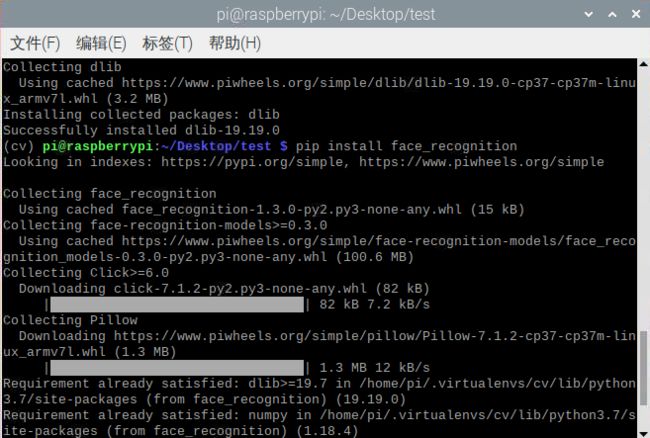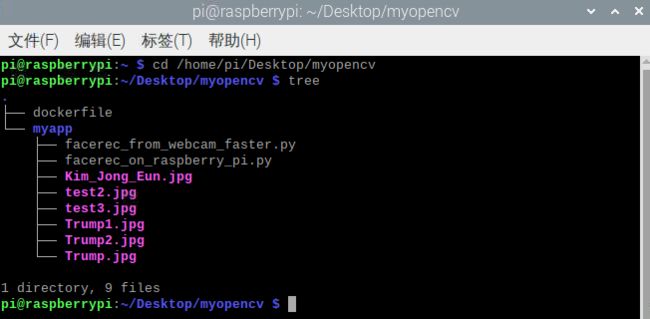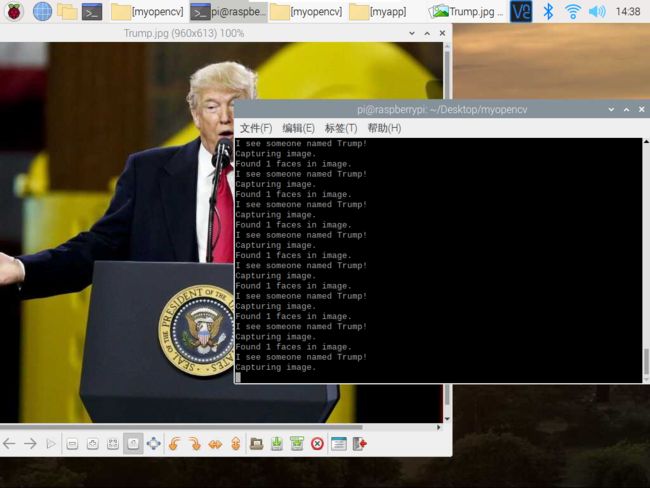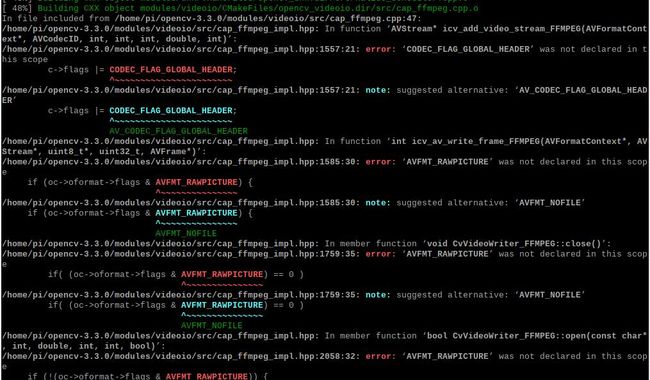综合系统实践 第7次实践作业
- 综合系统实践 第7次实践作业
- (1)在树莓派中安装opencv库
- 在Raspberry Pi 4B上安装OpenCV 4.1.2
- ①展开文件系统
- ②安装依赖关系
- ③下载OpenCV源代码
- ④Python 2.7或Python 3
- ⑤编译OpenCV
- ⑥安装OpenCV
- (2)使用opencv和python控制树莓派的摄像头
- (3)利用树莓派的摄像头实现人脸识别
- ①facerec_on_raspberry_pi.py
- ②facerec_from_webcam_faster.py
- (4)结合微服务的进阶任务
- ①安装Docker
- ②定制opencv镜像
- ③运行容器执行facerec_on_raspberry_pi.py
- ④选做:在opencv的docker容器中跑通步骤(3)的示例代码facerec_from_webcam_faster.py
- (5)遇到的问题及解决方法
- 问题1:环境/Users/myuser/.virtualenvs/iron不包含激活脚本
- 问题2:fatal error: features2d/test/test_detectors_regression.impl.hpp: 没有那个文件或目录
- 问题3: error: 'CODEC_FLAG_GLOBAL_HEADER' was not declared in this scope
- 问题4: fatal error: boostdesc_bgm.i: 没有那个文件或目录#include "boostdesc_bgm.i"
- (6)分工协作及总结
- (1)在树莓派中安装opencv库
(1)在树莓派中安装opencv库
在Raspberry Pi 4B上安装OpenCV 4.1.2
安装OpenCV的进程可能非常耗时且需要安装许多依赖项和先决条件。
①展开文件系统
如果使用全新的Raspbian Stretch安装,首先需要扩展文件系统,以包括micro-SD卡上的所有可用空间:
sudo raspi-config
然后选择“高级选项”菜单项:
接下来选择“扩展文件系统”:
回车确定
选择finish
然后重新启动Pi
sudo reboot
重新启动后,文件系统应该已经扩展到包含micro-SD卡上的所有可用空间。可以验证该盘已被执行扩展和检查的输出
df -h
Raspbian文件系统已经扩展到包含所有16GB的micro-SD卡。
但是,即使扩展了我的文件系统,我也已经使用了16GB卡的43%。
一件简单的事情就是删除LibreOffice和Wolfram引擎,以释放Pi上的一些空间:
sudo apt-get purge wolfram-engine
sudo apt-get purge libreoffice*
sudo apt-get clean
sudo apt-get autoremove
删除Wolfram引擎和LibreOffice后,可以回收近1GB!
②安装依赖关系
# 更新和升级任何现有的软件包
sudo apt-get update && sudo apt-get upgrade
# 安装开发工具CMake,帮助我们配置OpenCV构建过程
sudo apt-get install build-essential cmake pkg-config
# 图像I/O包,允许我们从磁盘加载各种图像文件格式。这种文件格式的例子包括JPEG,PNG,TIFF等
sudo apt-get install libjpeg-dev libtiff5-dev libjasper-dev libpng12-dev
# 视频I/O包。这些库允许我们从磁盘读取各种视频文件格式,并直接处理视频流
sudo apt-get install libavcodec-dev libavformat-dev libswscale-dev libv4l-dev
sudo apt-get install libxvidcore-dev libx264-dev
# OpenCV库附带一个名为highgui的子模块 ,用于在我们的屏幕上显示图像并构建基本的GUI。为了编译 highgui模块,我们需要安装GTK开发库
sudo apt-get install libgtk2.0-dev libgtk-3-dev
# OpenCV中的许多操作(即矩阵操作)可以通过安装一些额外的依赖关系进一步优化
sudo apt-get install libatlas-base-dev gfortran
# 安装Python 2.7和Python 3头文件,以便我们可以用Python绑定来编译OpenCV
sudo apt-get install python2.7-dev python3-dev
如果是新安装的操作系统,那么这些版本的Python可能已经是最新版本了(终端可以看到)。
③下载OpenCV源代码
现在我们已经安装了依赖项,从官方的OpenCV仓库中获取OpenCV 的 4.1.2归档。
cd ~
wget -O opencv.zip https://github.com/Itseez/opencv/archive/4.1.2.zip
unzip opencv.zip
我们需要完整安装 OpenCV 3(例如,可以访问SIFT和SURF等功能),因此我们还需要获取opencv_contrib存储库。
wget -O opencv_contrib.zip https://github.com/Itseez/opencv_contrib/archive/4.1.2.zip
unzip opencv_contrib.zip
注意:确保 opencv和 opencv_contrib版本相同。
如果版本号不匹配,那么可能会遇到编译时错误或运行时错误。
④Python 2.7或Python 3
在我们开始在我们的Raspberry Pi 3上开始编译OpenCV之前
首先需要安装 Python包管理器pip:
wget https://bootstrap.pypa.io/get-pip.py
sudo python get-pip.py
sudo python3 get-pip.py
可能会收到一条消息,指出在发出这些命令时pip已经是最新的,但最好不要跳过这一步 。
接下来安装virtualenv和 virtualenvwrapper
首先,了解虚拟环境是一种特殊的工具,通过为每个环境创建独立的,独立的 Python环境来保持不同项目所需的依赖关系,这一点很重要。
总之,它解决了“Project X取决于版本1.x,但项目Y需要4.x”的困境
安装python虚拟机
sudo pip install virtualenv virtualenvwrapper
sudo rm -rf ~/.cache/pip
配置~/.profile,添加内容:
# virtualenv and virtualenvwrapper
export WORKON_HOME=$HOME/.virtualenvs
export VIRTUALENVWRAPPER_PYTHON=/usr/bin/python3
source /usr/local/bin/virtualenvwrapper.sh
使之生效
source ~/.profile
使用Python3 安装虚拟机
mkvirtualenv cv -p python3
虚拟机完成安装之后,后续的所有操作全部在虚拟机中进行。按照教程的说明,一定要看清楚命令行前面是否有(cv),以此作为是否在虚拟机的判断!
需要重新进入虚拟机,可运行下面的命令
source ~/.profile
workon cv
再次提醒:后续所有操作均在虚拟机中
安装numpy
pip install numpy
⑤编译OpenCV
cd ~/opencv-4.1.2/
mkdir build
cd build
cmake -D CMAKE_BUILD_TYPE=RELEASE \
-D CMAKE_INSTALL_PREFIX=/usr/local \
-D INSTALL_PYTHON_EXAMPLES=ON \
-D OPENCV_EXTRA_MODULES_PATH=~/opencv_contrib-4.1.2/modules \
-D BUILD_EXAMPLES=ON ..
编译之前配置交换空间大小
在开始编译过程之前,应 增加交换空间的大小。这使OpenCV可以使用 Raspberry PI的所有四个内核进行编译,而不会由于内存问题而挂起编译。
把交换空间交换空间增大到 CONF_SWAPSIZE=1024
# 虚拟机中sudo才可以修改
sudo nano /etc/dphys-swapfile
sudo /etc/init.d/dphys-swapfile stop
sudo /etc/init.d/dphys-swapfile start
# 开始编译(顺利的话1个多小时就可以编译完,运气不好的话遇到很多坑可能一天都...)
make
编译过程好费时间长而且一波三折,遇到了一些坑(好多ERROR),重新烧录了好几次备份系统(差点自闭QAQ),但好在都一一解决了,遇到问题详情及解决办法在(5)。
⑥安装OpenCV
sudo make install
sudo ldconfig
检查OpenCV的安装位置
ls -l /usr/local/lib/python3.7/site-packages/
cd ~/.virtualenvs/cv/lib/python3.7/site-packages/
ln -s /usr/local/lib/python3.7/site-packages/cv2 cv2
验证安装
source ~/.profile
workon cv
python
import cv2
cv2.__version__
关于opencv的编译安装,可以参考
- Adrian Rosebrock的Raspbian Stretch: Install OpenCV 3 + Python on your Raspberry Pi。
- Raspberry Pi 4B 使用OpenCV访问摄像头picamera模块
- Raspbian Stretch:在你的Raspberry Pi上安装OpenCV 3 + Python
- OpenCV 各种安装错误汇总
(2)使用opencv和python控制树莓派的摄像头
安装picreame
source ~/.profile
workon cv
pip install "picamera[array]"
拍照测试
按照教程给的示例代码,验证Python控制摄像头拍照的效果,增加示例代码中sleep的时间,让摄像头曝光时间增加,拍照效果比较好。
示例代码
# import the necessary packages
from picamera.array import PiRGBArray
from picamera import PiCamera
import time
import cv2
# initialize the camera and grab a reference to the raw camera capture
camera = PiCamera()
rawCapture = PiRGBArray(camera)
# allow the camera to warmup
# 此处把0.1改成了5
time.sleep(5)
# grab an image from the camera
camera.capture(rawCapture, format="bgr")
image = rawCapture.array
# display the image on screen and wait for a keypress
cv2.imshow("Image", image)
cv2.waitKey(0)
- 参考教程:还是可以参考Adrian Rosebrock的Accessing the Raspberry Pi Camera with OpenCV and Python跑通教程的示例代码(有可能要调整里面的参数)
(3)利用树莓派的摄像头实现人脸识别
安装依赖库dlib,face_recognition
在命令行输入:
source ~/.profile
workon cv
pip install dlib
pip install face_recognition
切换到放有要加载图片和python代码的目录下
①facerec_on_raspberry_pi.py
示例代码如下:
# This is a demo of running face recognition on a Raspberry Pi.
# This program will print out the names of anyone it recognizes to the console.
# To run this, you need a Raspberry Pi 2 (or greater) with face_recognition and
# the picamera[array] module installed.
# You can follow this installation instructions to get your RPi set up:
# https://gist.github.com/ageitgey/1ac8dbe8572f3f533df6269dab35df65
import face_recognition
import picamera
import numpy as np
# Get a reference to the Raspberry Pi camera.
# If this fails, make sure you have a camera connected to the RPi and that you
# enabled your camera in raspi-config and rebooted first.
camera = picamera.PiCamera()
camera.resolution = (320, 240)
output = np.empty((240, 320, 3), dtype=np.uint8)
# Load a sample picture and learn how to recognize it.
print("Loading known face image(s)")
image = face_recognition.load_image_file("test.jpg")
face_encoding = face_recognition.face_encodings(image)[0]
# Initialize some variables
face_locations = []
face_encodings = []
while True:
print("Capturing image.")
# Grab a single frame of video from the RPi camera as a numpy array
camera.capture(output, format="rgb")
# Find all the faces and face encodings in the current frame of video
face_locations = face_recognition.face_locations(output)
print("Found {} faces in image.".format(len(face_locations)))
face_encodings = face_recognition.face_encodings(output, face_locations)
# Loop over each face found in the frame to see if it's someone we know.
for face_encoding in face_encodings:
# See if the face is a match for the known face(s)
match = face_recognition.compare_faces([face_encoding], face_encoding)
name = ""
if match[0]:
name = "Trump"
print("I see someone named {}!".format(name))
一开始摄像头没有对准照片,后面照片移入摄像头拍摄范围,可以看到识别成功。
-
test.jpg用于上传转换格式提取特征值保存
-
Trump.jpg用于测试是否准确识别出Trump
-
Kim Jong Eun.jpg用于测试是否准确识别出Unknown Person
测试test2.jpg并查看是否准确识别Trump
当照片切换到Kim Jong Eun.jpg,可以看到识别出一张人脸而且是Unknown Person
②facerec_from_webcam_faster.py
示例代码如下:
import face_recognition
import cv2
import numpy as np
# This is a demo of running face recognition on live video from your webcam. It's a little more complicated than the
# other example, but it includes some basic performance tweaks to make things run a lot faster:
# 1. Process each video frame at 1/4 resolution (though still display it at full resolution)
# 2. Only detect faces in every other frame of video.
# PLEASE NOTE: This example requires OpenCV (the `cv2` library) to be installed only to read from your webcam.
# OpenCV is *not* required to use the face_recognition library. It's only required if you want to run this
# specific demo. If you have trouble installing it, try any of the other demos that don't require it instead.
# Get a reference to webcam #0 (the default one)
video_capture = cv2.VideoCapture(0)
# Load a sample picture and learn how to recognize it.
Trump_image = face_recognition.load_image_file("Trump.jpg")
Trump_face_encoding = face_recognition.face_encodings(Trump_image)[0]
# Load a second sample picture and learn how to recognize it.
Kim_Jong_Eunimage = face_recognition.load_image_file("Kim_Jong_Eun.jpg")
Kim_Jong_Eunface_encoding = face_recognition.face_encodings(Kim_Jong_Eunimage)[0]
# Create arrays of known face encodings and their names
known_face_encodings = [
Trump_face_encoding,
Kim_Jong_Eunface_encoding
]
known_face_names = [
"Trump",
"Kim_Jong_Eun"
]
# Initialize some variables
face_locations = []
face_encodings = []
face_names = []
process_this_frame = True
while True:
# Grab a single frame of video
ret, frame = video_capture.read()
# Resize frame of video to 1/4 size for faster face recognition processing
small_frame = cv2.resize(frame, (0, 0), fx=0.25, fy=0.25)
# Convert the image from BGR color (which OpenCV uses) to RGB color (which face_recognition uses)
rgb_small_frame = small_frame[:, :, ::-1]
# Only process every other frame of video to save time
if process_this_frame:
# Find all the faces and face encodings in the current frame of video
face_locations = face_recognition.face_locations(rgb_small_frame)
face_encodings = face_recognition.face_encodings(rgb_small_frame, face_locations)
face_names = []
for face_encoding in face_encodings:
# See if the face is a match for the known face(s)
matches = face_recognition.compare_faces(known_face_encodings, face_encoding)
name = "Unknown"
# # If a match was found in known_face_encodings, just use the first one.
# if True in matches:
# first_match_index = matches.index(True)
# name = known_face_names[first_match_index]
# Or instead, use the known face with the smallest distance to the new face
face_distances = face_recognition.face_distance(known_face_encodings, face_encoding)
best_match_index = np.argmin(face_distances)
if matches[best_match_index]:
name = known_face_names[best_match_index]
face_names.append(name)
process_this_frame = not process_this_frame
# Display the results
for (top, right, bottom, left), name in zip(face_locations, face_names):
# Scale back up face locations since the frame we detected in was scaled to 1/4 size
top *= 4
right *= 4
bottom *= 4
left *= 4
# Draw a box around the face
cv2.rectangle(frame, (left, top), (right, bottom), (0, 0, 255), 2)
# Draw a label with a name below the face
cv2.rectangle(frame, (left, bottom - 35), (right, bottom), (0, 0, 255), cv2.FILLED)
font = cv2.FONT_HERSHEY_DUPLEX
cv2.putText(frame, name, (left + 6, bottom - 6), font, 1.0, (255, 255, 255), 1)
# Display the resulting image
cv2.imshow('Video', frame)
# Hit 'q' on the keyboard to quit!
if cv2.waitKey(1) & 0xFF == ord('q'):
break
# Release handle to the webcam
video_capture.release()
cv2.destroyAllWindows()
验证识别成功
因为左边的人物图像没有上传提取特征值保存,所以识别为unknown,识别成功
- 人脸识别有开源的python库face_recognition,这当中有很多示例代码
- 参考教程:树莓派实现简单的人脸识别
- 要求:跑通face_recognition的示例代码facerec_on_raspberry_pi.py以及facerec_from_webcam_faster.py
(4)结合微服务的进阶任务
①安装Docker
下载安装脚本
curl -fsSL https://get.docker.com -o get-docker.sh
运行安装脚本(阿里云镜像)
sh get-docker.sh --mirror Aliyun
查看docker版本,验证是否安装成功
添加用户到docker组
sudo usermod -aG docker pi
重新登陆让用户组生效
exit
ssh pi@raspiberry
重启之后,docker指令之前就不需要加sudo了
②定制opencv镜像
拉取镜像
docker pull sixsq/opencv-python
创建并运行容器
docker run -it sixsq/opencv-python /bin/bash
在容器中,用pip3安装 "picamera[array]",dlib和face_recognition
pip3 install "picamera[array]"
pip3 install dlib
pip3 install face_recognition
exit
自定义镜像
- Dockerfile
FROM opencv1
RUN mkdir /myapp
WORKDIR /myapp
COPY myapp .
构建镜像
docker build -t opencv2 .
查看镜像
③运行容器执行facerec_on_raspberry_pi.py
docker run -it --device=/dev/vchiq --device=/dev/video0 --name myopencv opencv2
python3 facerec_on_raspberry_pi.py
④选做:在opencv的docker容器中跑通步骤(3)的示例代码facerec_from_webcam_faster.py
在Windows系统中安装Xming
开启树莓派的ssh配置中的X11
查看DISPLAY环境变量值
printenv
编写run.sh
#sudo apt-get install x11-xserver-utils
xhost +
docker run -it \
--net=host \
-v $HOME/.Xauthority:/root/.Xauthority \
-e DISPLAY=:10.0 \
-e QT_X11_NO_MITSHM=1 \
--device=/dev/vchiq \
--device=/dev/video0 \
--name facerecgui \
opencv2 \
python3 facerec_from_webcam_faster.py
打开终端,运行run.sh
sh run.sh
可以看到在windows的Xvideo可以正确识别人脸。
参考教程
(5)遇到的问题及解决方法
问题1:环境/Users/myuser/.virtualenvs/iron不包含激活脚本
在使用Python3 安装虚拟机的时候出现下图的安装错误
卸载virtualenv和virtualenvwrapper
sudo pip3 uninstall virtualenv virtualenvwrapper
看到virtualenvwrapper我安装的版本是5.0.0。
检查了PyPi,它仍然是4.8.4版。
重新安装了两者并指定了版本
sudo pip3 install virtualenv virtualenvwrapper=='4.8.4'
我获取了.bashrc的源代码,其中附加了设置:
VIRTUALENVWRAPPER_PYTHON=/usr/bin/python3
VIRTUALENVWRAPPER_VIRTUALENV=/usr/local/bin/virtualenv
export PATH=/usr/local/bin:$PATH
export WORKON_HOME=~/.virtualenvs
source /usr/local/bin/virtualenvwrapper.sh
Python3重新安装虚拟机
mkvirtualenv cv -p python3
参考教程
Error: Environment /Users/myuser/.virtualenvs/iron does not contain activation script
ERROR: Environment '/home/pi/.virtualenvs/cv' does not contain an activate script
问题2:fatal error: features2d/test/test_detectors_regression.impl.hpp: 没有那个文件或目录
头文件include路径不对,解决方法如下:
将opencv-4.1.2/modules/features2d/test/文件下的
- test_descriptors_regression.impl.hpp
- test_detectors_regression.impl.hpp
- test/test_detectors_invariance.impl.hpp
- test_descriptors_invariance.impl.hpp
- test_invariance_utils.hpp
拷贝到opencv_contrib-4.1.0/modules/xfeatures2d/test/文件下。
 同时,将opencv_contrib-4.1.2/modules/xfeatures2d/test/test_features2d.cpp文件下的
同时,将opencv_contrib-4.1.2/modules/xfeatures2d/test/test_features2d.cpp文件下的
#include "features2d/test/test_detectors_regression.impl.hpp"
#include "features2d/test/test_descriptors_regression.impl.hpp"
改成:
#include "test_detectors_regression.impl.hpp"
#include "test_descriptors_regression.impl.hpp"
之后编译过程中可能还会遇到类似问题,也是按照同样的做法。
参考博客
在Ubuntu16.04上编译opencv4.1.0-gpu带contrib版本碰到的问题
问题3: error: 'CODEC_FLAG_GLOBAL_HEADER' was not declared in this scope
解决方法:
在 /home/pi/opencv-4.1.2/modules/videoio/src/cap_ffmpeg_impl.hpp 里最顶端添加
#define AV_CODEC_FLAG_GLOBAL_HEADER (1 << 22)
#define CODEC_FLAG_GLOBAL_HEADER AV_CODEC_FLAG_GLOBAL_HEADER
#define AVFMT_RAWPICTURE 0x0020
参考博客
Ubuntu 源码安装opencv320 报错 error: 'CODEC_FLAG_GLOBAL_HEADER' was not declared in this scope
问题4: fatal error: boostdesc_bgm.i: 没有那个文件或目录#include "boostdesc_bgm.i"
解决方法:
需要下列文件
-
boostdesc_bgm.i
-
boostdesc_bgm_bi.i
-
boostdesc_bgm_hd.i
-
boostdesc_lbgm.i
-
boostdesc_binboost_064.i
-
boostdesc_binboost_128.i
-
boostdesc_binboost_256.i
-
vgg_generated_120.i
-
vgg_generated_64.i
-
vgg_generated_80.i
-
vgg_generated_48.i
网上下载压缩包( 提取码:p50x )拷贝到opencv_contrib/modules/xfeatures2d/src/目录下并且解压**
参考博客
安装OpenCV时提示缺少boostdesc_bgm.i文件的问题解决方案
(6)分工协作及总结
小组成员名单
| 学号 | 姓名 | 分工 |
|---|---|---|
| 071703428 | 叶梦晴 | 查阅资料、实际操作及博客撰写 |
| 031702444 | 李尚佳 | 实际操作、解决问题及博客撰写 |
| 181700134 | 宋娟 | 查阅资料及提供代码 |
在线协作
①通过TeamViewer远程控制有树莓派同学的电脑进行实际操作


②通过QQ语音和文件传输分享博客资料和沟通
③实验小结
本次实验学习了如何使用opencv和python控制树莓派的摄像头、利用树莓派的摄像头实现人脸识别以及opencv的docker容器中实现了人脸识别,整体操作下来没有特别大无法解决的问题。就是在搭建opencv库时,因为各种错误(大大小小的坑踩了个遍,环境重新烧录了好几遍QAQ),好几次编译进度条都到不了100%,花了很多很多的时间,在线协作和学习理论知识以及实践操作合计大概有20h,还有其他一些小问题都记录在上面了。通过这次实验体会到树莓派的用处真的很大,而且使用起来也真的很方便,期待下次能做出一个有创意又有意思的实验!


















































